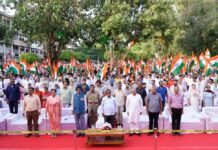Mother Tongue: The building blocks of education
By Shri Dharmendra Pradhan
India is a multilingual country with a plethora of languages spoken in its different parts. Besides twenty-two languages in the eighth schedule of the Constitution and ninety-nine other languages spoken by more than ten thousand speakers, there are many other languages and mother tongues which are spoken in smaller linguistic communities. It is an inherent quality of the Indian social system that we use and enjoy multiple languages. Languages keep us together. All our diversities are visible only from the outside, but in reality, we are one. We celebrate this diversity in unity.
This year’s edition of International Mother Language Day celebrated on 21st February focused on the theme ‘multilingual education – a necessity to transform education’. In line with the UNESCO’s policy, we reaffirm our conviction to promote the use of mother tongues, which will serve not only to enhance education at all levels but also develop fuller awareness of the rich linguistic, cultural and knowledge traditions of our country.
We support and facilitate children’s right to education in their mother tongue as emphasised by Prime Minster Shri Narendra Modi, when he says, “After the National Education Policy came, there has been much discussion on what will be the language of instruction. Here we have to understand one scientific fact that language is the medium of education, not entire education itself. People caught in too much of ‘bookish knowledge’ often fail to grasp this distinction. Whatever language the child can learn easily in, should be the medium of instruction.” The National Education Policy (NEP) 2020 advocates for promotion of multilingualism and highlights the power of language in teaching and learning. It can accelerate efforts in ensuring lifelong equitable education for the inclusion of using mother tongue because multilingual education based on mother tongue should be a key component of our education system. We emphasise the importance of encouraging the use of mother tongues in the curriculum and in the classroom. Due to a long period of colonisation, we have neglected Indian languages and their rich linguistic traditions. We have to decolonise our minds, get rid of our servile attitude and create our own path to achieve greater heights. The NEP 2020 lays emphasis on universalisation of early childhood care and education, and learning in all Indian languages.
Mother tongue is the true vehicle of transmission, which is fundamental to our identities, an inseparable part of our personalities and must never be lost as it carries the rich cultural fabric of our existence. The potential of multilingualism to transform education from a lifelong learning perspective and in different contexts is well established. Not being able to use or access knowledge and information in one’s mother tongue can limit the development of the personality and intellectual freedom. We should encourage parents, caregivers, and teachers to support their children’s learning in mother tongue so that their mother tongue is developed alongside other languages of the school. This will not only support learners with developing academic literacy in their own language but also enable the comprehension of concepts and the learning of other languages.
The multilingual character of India necessitates the inclusion of several languages in the curriculum for school education. Studies reveal that the inclusion of several languages in the school curriculum is not considered to be an additional load. Numerous studies have shown that primary learning through the mother tongue best develops the cognitive abilities of a child and facilitates the acquisition of basic literacy skills and the understanding of complex concepts. In other words, children who receive their primary lessons in the mother tongue build a better educational foundation compared to those who receive education through their second language. The use of only one particular language as the medium of instruction not only leaves many children illiterate in their mother tongue, it also fosters low achievement levels in that language itself. Language is a major factor in the case of school dropouts and stagnation in education.
Accepting the complex linguistic landscape of our country, we are going to implement mother-tongue-based multilingual education focusing on proficiency in the language of the classroom and that of learners, and a high level of skill in teaching. The children will be exposed to different languages with a particular emphasis on the mother tongue, starting from the foundational stage. The three-language policy will continue to be implemented while keeping in mind the Constitutional provisions, aspirations of the people, regions and the Union, and the need to promote multilingual education and national unity. The three languages, which will include the mother tongues and local/regional languages, will be the choices of the students, regions and states. High-quality textbooks, including those in school subjects, will be made available in mother tongues, and all efforts will be made to ensure that mother tongue medium education becomes ‘aspirational’.
Learning another Indian language for children is easier since all Indian languages belong to one language family called the Bharatiya Bhasha Pariwar. Learning classical languages of India will provide access to rich repositories of literature and Indian Knowledge Systems. Learning through Indian language medium will not only make education more rooted in Bharat but also strengthen the cultural unity of India since culture and language are inseparable. Leveraging technology to give impetus to mother-tongue-medium education and to promote Indian languages will be a catalyst for the realization of ‘Ek Bharat Shreshtha Bharat’. We will not leave any stone unturned in supporting education through the mother languages of India.














